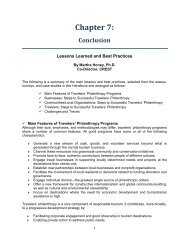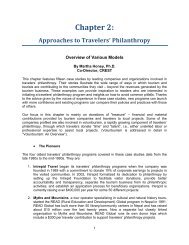Travelers' Philanthropy Handbook - Center for Responsible Travel
Travelers' Philanthropy Handbook - Center for Responsible Travel
Travelers' Philanthropy Handbook - Center for Responsible Travel
You also want an ePaper? Increase the reach of your titles
YUMPU automatically turns print PDFs into web optimized ePapers that Google loves.
organization to Myths and Mountains, READ Global runs its own donor trips whichinclude a $300 per traveler contribution to support travelers’ philanthropy projects.3. Holbrook <strong>Travel</strong> and its 40-room Selva Verde Lodge in Costa Rica built the SarapiquiConservation Learning <strong>Center</strong> (SCLC) in 1993 to provide a range of educationalactivities to the surrounding communities. In 2002, SCLC began offering community-runcultural and educational activities (classes in handicrafts, Latin dance, cooking, etc),home stays, service projects, and environmental field trips to U.S. visitors, especiallyhigh school students and teachers. The revenue from these classes is divided betweenthe community instructors and SCLC and now covers about 75% of the <strong>Center</strong>’soperating costs.4. International Galapagos Tour Operators Association (IGTOA) was founded in 1995by tour operators and NGOs involved in the Galapagos. It is a membership organizationdedicated to the preservation of the Galapagos through; improving professionalstandards within the tourism industry, advocacy campaigns on behalf of resourceconservation and responsible tourism, and raising funds to support a range ofconservation projects. Collectively, through a combination of membership dues andvisitor donations, IGTOA is raising about $90,000 a year to support conservationprojects in the Galapagos.• Range of Businesses and Types of InitiativesThe rich tapestry of travelers’ philanthropy initiativesexemplified through these case studies covers alltypes of tourism businesses, from individuallodgings in a single location to internationalcompanies supporting travelers’ philanthropyprograms around the globe to destination-widetravel funds. Both small and large operators canmake a substantial contribution. Working at a singlelocal level are companies like Hotel Punta Islita, acoastal resort in Costa Rica which hosts about 8000guests a year, has worked with residents in severalsmall rural communities to develop art andhandicraft projects, a pre-school, an outdoormuseum, and environmental education, along witha range of micro-enterprises. These benefits, plusthe fact that 85% of the hotel’s staff comes fromElephant ‘Moshi’ with new prosthesis, Friends of theAsian Elephant hospital, Thailand.Credit: Friends of the Asian Elephantthese communities, mean that half of every tourist dollar spent at the resort stays in this ratherremove and rural area. By comparison, sometimes less than 10% stays in local areas.Increasingly, large global hotel chains, tour operators, and airlines are developing travelers’philanthropy programs as part of their corporate social responsibility. One leader in thismovement among large operators is the Australian company, Intrepid <strong>Travel</strong> which takes 80,000travelers a year to over 100 countries. Through travelers’ philanthropy, Intrepid providesfinancial and material support to projects in 20 countries in Asia, Africa, Latin America, andEastern Europe.26















